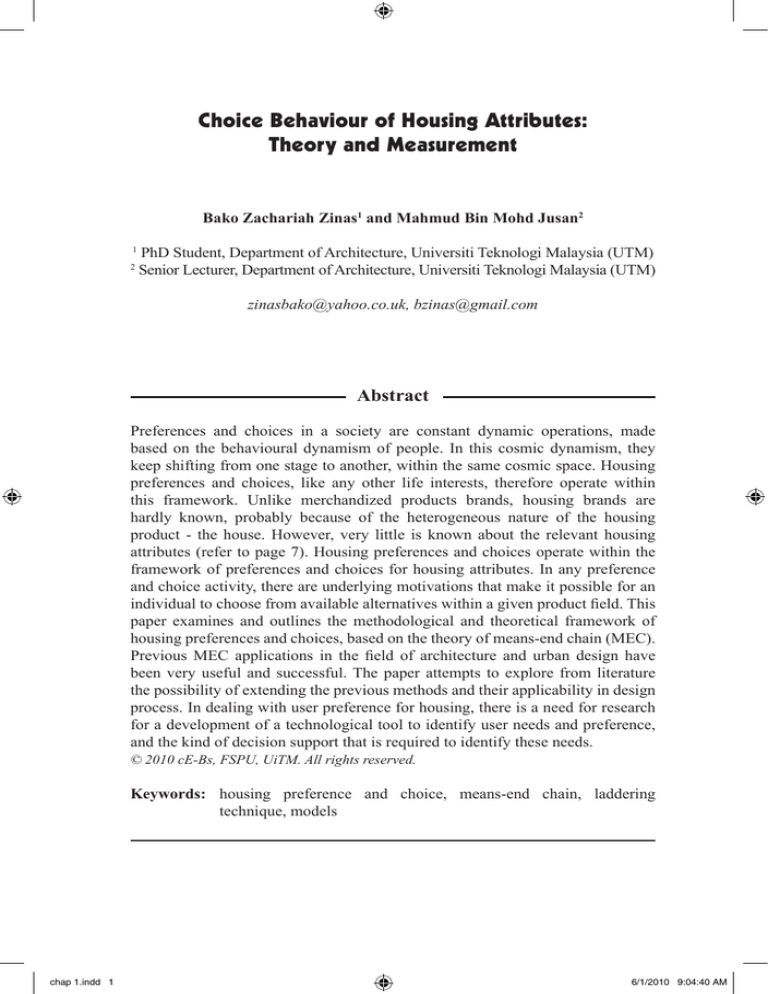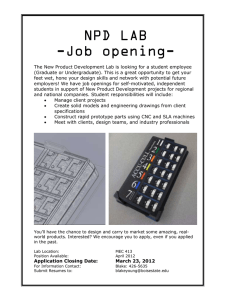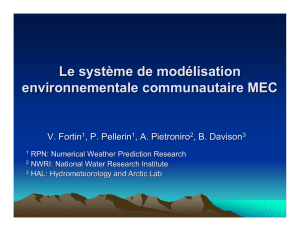
Zinas, B., Z, and Mohd Jusan, M.
Choice Behaviour of Housing Attributes:
Theory and Measurement
Choice Behaviour of Housing Attributes:
Theory and Measurement
Bako Zachariah Zinas1 and Mahmud Bin Mohd Jusan2
1
2
PhD Student, Department of Architecture, Universiti Teknologi Malaysia (UTM)
Senior Lecturer, Department of Architecture, Universiti Teknologi Malaysia (UTM)
zinasbako@yahoo.co.uk, bzinas@gmail.com
Abstract
Preferences and choices in a society are constant dynamic operations, made
based on the behavioural dynamism of people. In this cosmic dynamism, they
keep shifting from one stage to another, within the same cosmic space. Housing
preferences and choices, like any other life interests, therefore operate within
this framework. Unlike merchandized products brands, housing brands are
hardly known, probably because of the heterogeneous nature of the housing
product - the house. However, very little is known about the relevant housing
attributes (refer to page 7). Housing preferences and choices operate within the
framework of preferences and choices for housing attributes. In any preference
and choice activity, there are underlying motivations that make it possible for an
individual to choose from available alternatives within a given product field. This
paper examines and outlines the methodological and theoretical framework of
housing preferences and choices, based on the theory of means-end chain (MEC).
Previous MEC applications in the field of architecture and urban design have
been very useful and successful. The paper attempts to explore from literature
the possibility of extending the previous methods and their applicability in design
process. In dealing with user preference for housing, there is a need for research
for a development of a technological tool to identify user needs and preference,
and the kind of decision support that is required to identify these needs.
© 2010 cE-Bs, FSPU, UiTM. All rights reserved.
Keywords: housing preference and choice, means-end chain, laddering
technique, models
chap 1.indd 1
6/1/2010 9:04:40 AM
ajE-Bs, Asian Journal of Environment-Behaviour Studies
1.
Introduction
Preferences and choices are lifetime phenomena. Every person lives and operates
within the framework of choosing from alternatives of life’s endeavours in
whatever area. Preference is a function of choice. Molin et al. (1996) put it this
way, “choices are assumed to reflect preferences”. We live in a world of shifting
preferences and choices; and in a society that is in a constant dynamic operation,
preferences and choices are made based on the behavioural dynamism of people.
In this cosmic dynamism, preferences and choices keep shifting from one stage
to another within the same cosmic space. The choice process is considered to be
a dynamic process in which people identify a problem to be solved (Coolen &
Hoekstra, 2001). Molin et al. (1996) assert that it is only in the act of actual choice
that individuals can reveal their preferences. Housing preferences and choices like
any other life interests therefore operate within this framework. Timmermans et
al. (1994) and Coolen & Hoekstra (2001) state that the topic of housing choice
and housing preference continues to be heavily researched, as an area of interest
to scholars in various and numerous disciplines. Although housing brands are
hardly known, much is known about the relevant housing attributes (Coolen &
Hoekstra, 2001). Housing preferences and choices operate within the framework
of preferences and choices for housing attributes. In any preference and choice
activity, there are underlying motivations that make it possible for an individual
to choose from available alternatives within a given product field. What motivate
housing users to choose and/or prefer a given set of attributes over and above
other sets of attributes? Preferences and choices are regarded as value-oriented and
goal-directed activities (Coolen & Hoekstra, 2001). What instruments measure
these choice behaviours?
The Means-End Chain (MEC) model (Gutman, 1982) originally developed
for merchandized products, of which application in the field of architecture and
urban design has been very useful and successful in the past few decades (Tania
et al., 2006), is the framework within which this paper is anchored. MEC utilizes
the laddering technique for data collection, analysis and interpretation (Mahmud,
2007; Coolen & Hoekstra, 2001). Many different approaches in measuring
user preferences have been suggested or developed, ranging from simple direct
questioning of respondents to sophisticated measurement approaches such as
conjoint analysis, which allows researchers to test the assumptions underlying
their measurement approaches. Conjoint analysis is a measurement approach
in which users are requested to express their preference for attribute profiles,
which are constructed according to an experimental design (Orzechowski, 2004).
There are basically two broad modelling approaches to measure housing choice
and preference- the revealed housing choice models and the stated housing
preference and choice models. Revealed models are based on observational data
of households’ actual housing choices in real markets; while stated models are
based on the premise that observed choices will also reflect the joint influence of
preferences, market conditions and availability (Timmermans et al., 1994). These
chap 1.indd 2
6/1/2010 9:04:40 AM
Zinas, B., Z, and Mohd Jusan, M.
Choice Behaviour of Housing Attributes:
Theory and Measurement
models are based on people’s expressed preferences and choices. Stated models
are classified into algebraic and non-algebraic methods. The algebraic models
are compositional and decompositional or conjoint models, while non-algebraic
models are decision plan nets and measurement or residential image approach.
1.1
Objective of the Study
This paper is a conceptual one, geared towards presenting a research platform
using the Means-End Chain (MEC) model for housing researchers, and also
initiating an interest for housing researchers in employing the use of MEC model
as a research tool. The sole objective is to “market” the MEC research model as a
tool for measuring housing attributes in choice behaviour research.
1.2
Significance of the Study
Housing is a complex and heterogeneous product in its setting, the cognitive
structures of housing users for housing attributes is also complex as well as their
choice behaviours. The Means-End Chain (MEC) model has been found in its
application to successfully handle and measure these complexities in housing
research. The adoption and application of MEC model in measuring these
complexities in housing is the significance of this paper.
1.3
Limitation of the Study
This paper is limited to presenting only a conceptual framework for conducting
housing research using the MEC model and other models for choice and preference
of housing attributes, and the corresponding choice behaviours. It is not presented
as a research paper.
2. Theoretical Framework of MEC Theory
This section provides a brief overview of theoretical framework of MEC theory
used in research process. It explains what MEC is, its underlying concept, its
variables, and the methodology in MEC for data collection, analysis and
interpretation.
2.1 The Means-End Chain (MEC)
MEC has a long research history. Gutman (1982) first introduced the concept, with
a focus on qualitative in-depth understanding of consumer motives. Reynolds and
Gutman (1988) made MEC well-accepted by providing a hands-on description
of how to conduct, analyse and use MEC interviews (Weijters & Muylle, 2008).
Kaciak and Cullen (2006) assert that MEC has been a popular and ever-evolving
research domain since its introduction. Gutman’s MEC theory (1982) was inspired
chap 1.indd 3
6/1/2010 9:04:40 AM
ajE-Bs, Asian Journal of Environment-Behaviour Studies
by research from Rokeach (1968), and Yankelovich (1981) who showed that values
direct people’s behaviour in all aspects of their lives (Boer & McCarthy, 2004).
Although MEC original purpose was for linking consumers’ values to their choice
behaviour in marketing and consumer research, it is becoming popular in other
areas (Tania et al., 2006) like architecture, urban design, advertising, information
technology, and organisational management (Rugg et al., 2002).
Gutman (1982) defines MEC as a model that seeks to explain how a product
or service selection facilitates the achievement of desired end states. MEC links
sequentially products’ attributes (A) to consequences of product use (C) and to
individuals’ personal values (V). The resultant A-C-V sequence forms what is called
means-end chain or ladder. Coolen et al. (2002) view MEC as a model that relates
the choice of a good (defined as a collection of attributes) to its contribution to
achieving objectives and values. They explain that “means” are objects (products)
or activities in which people engage e.g. running, reading, cooking, etc, and “end”
refers to valued states of being, such as, happiness, security, and accomplishment.
The essential idea in MEC theory is that consumers choose actions which produce
the desired consequences and which minimise the undesirable consequences.
Reynolds and Whitlark (1995) paradoxically stress that while a means can be an
end, an end can also be a means. Meesters (2005) opines that in order to make
the right choice between the different goods with different consequences, the
consumer must learn which good possesses the attributes producing the desirable
consequence.
2.2 Assumptions of MEC
The original MEC model by Gutman (1982) is based on four assumptions. First, it
assumes that objectives and values influence choice processes; secondly, it assumes
that people can keep track of the enormous diversity of goods by grouping them
in sets or classes so as to produce the complexities of choice; thirdly, it assumes
that behaviour of consumers has consequences, although these consequences do
not have to be for everybody; and fourthly, it assumes that consumers learn to
associate particular consequences with particular behaviours (Gutman, 1982;
Coolen & Hoekstra, 2001; Tania et al., 2006).
2.3 Conceptual structure of MEC
The variables or constructs of the original structure of MEC model (Gutman,
1982) comprise attributes, consequences and values (Fig. 1). The linkage between
values and consequences is of essential importance in the MEC model. Coolen et
al. (2002) give the linkages as, firstly, that a certain good must be consumed or
used to realise a desirable consequence; and secondly, it is the linkage between
consequences and the attributes of goods.
chap 1.indd 4
6/1/2010 9:04:40 AM
Zinas, B., Z, and Mohd Jusan, M.
Attributes
Choice Behaviour of Housing Attributes:
Theory and Measurement
Consequences
Values
(Source: Gutman, 1982)
Figure 1: Structure of MEC
The conceptual model of MEC theory can be summarised in the following
propositions (Pieters et al., 1991): firstly, that the subjective knowledge about
consumers’ goods and services is organised in associative networks; secondly, that
the concepts in these networks that are relevant for consumer decision-making
are attributes of products, consequences of product use, and consumers’ values;
thirdly, that attributes, consequences and values are ordered hierarchically; and
fourthly, that the structure of consumers’ knowledge about goods and services
influences relevant consumer behaviour (Pieters et al., 1991; Coolen & Hoekstra,
2001).
Olson and Reynolds (1983) proposed some modifications on Gutman (1982)
model, broadening the chain levels. The broadened model recommends that the
attributes be sub-divided into concrete and abstract; consequences into functional
and psychological; and personal values into instrumental and terminal (Botschen
et al., 1999; Valette-Florence & Rapacchi, 1991). The broadened conceptual
framework of MEC model is as illustrated in Figure 2.
Associative (Cognitive) Networks
Attribute
Concrete
Attribute
Consequences
Abstract
Attribute
Values
Instrumental
Values
Functional
Consequences
Terminal
Values
Psychological
Consequences
Hierarchical Order
(Source: Olson & Reynolds, 1983; Gutman, 1982)
Figure 2: Broadened Structure of MEC Model
chap 1.indd 5
6/1/2010 9:04:41 AM
ajE-Bs, Asian Journal of Environment-Behaviour Studies
2.3.1 Attributes
The New Webster’s dictionary defines attribute as “a quality proper to a
characteristic of a person or thing”. Valette-Florence and Rapacchi (1991) view
attributes as features or aspects of products or services. Gengler et al. (1999)
perceive them as relatively concrete meanings that represent physical or perceptible
characteristics in a product. According to Botschen et al. (1999), attributes are
characteristics of products, services, or behaviour that are preferred or sought for
by consumers. While agreeing to all these definitive views, attributes can be seen
as the intrinsic and physical features, properties or characteristics that define a
product or person.
Attributes are of two levels: concrete attributes and abstract attributes (Olson
& Reynolds, 1983). Abstract attributes are defined as the directly perceptible
physical characteristics of a product, e.g. price, color, and weight (Vriens &
Hofstede, 2000), relatively intangible characteristics, such as style and brand (Lin,
2002), or perceived value or importance (Botschen et al., 1999). Mahmud (2007)
classifies concrete attributes into two groups, namely, element and relationship,
as it relates to housing. He sees abstract attributes as “meanings” perceived by the
housing consumer.
2.3.2 Consequences
‘Consequences’ can be defined as “that which follows something and arises from
it” (New Webster’s Dictionary, 1995). Coolen and Hoekstra (2001) consider
consequences as every direct or indirect result of a person’s behaviour. They
are the effects produced by a given product; the characteristics that are less
directly perceptible in a product or brand, and are the result of various attributes
combinations (Vriens & Hofstede, 2000). Lin (2002) opines that consequences
are what the consumer feels after consuming the product, and this might be a
positive feeling e.g. benefits, or a negative feeling, e.g. perceived risks. In specific
situations, Valette-Florence and Rapacchi (1991) opine that consequences
represent behaviours.
Consequences are at the intermediary level in the chain, and have a
more abstract meaning that reflects perceived benefits (Gengler et al., 1999).
Mahmud (2007) relying on Gutman (1982), states that there are two categories
of consequences in Gutman’s MEC, namely, functional consequences and
abstract consequences. He opines that functional consequences refer to practical
benefits and performance outputs, while abstract consequences are feelings or
social considerations. Consequences may be physiological (satisfying hunger,
thirst, or other physiological needs) or psychological (self-esteem, improve
outlook in the future) or sociological (enhance status, group membership)
in nature. They may occur directly (e.g. buying a new dress, I feel better) or
indirectly (e.g., because I feel better, people react more favourably to me)
(Gutman, 1982).
chap 1.indd 6
6/1/2010 9:04:41 AM
Zinas, B., Z, and Mohd Jusan, M.
Choice Behaviour of Housing Attributes:
Theory and Measurement
2.3.3 Values
Values are at the most abstract level in the chain. Rokeach (1968) defines values
as enduring benefits that a particular mode of conduct or particular end-state of
existence is personally and socially preferable to alternative modes of conduct
or end-states of existence. They are the benefits and relatively stable conditions
that have a strong emotional impact e.g. security, happiness, fun, and enjoyment
(Vriens & Hofstede, 2000). Dibley and Baker (2001) opine that values determine,
regulate, and modify relationships between individuals, organizations, institutions,
and societies. According to Valette-Florence and Rapacchi (1991), personal values
provide general guidance and are part of our lives. Schwartz (1994) sees values
as “desirable translational goals, varying in importance that serves as guiding
principles in the life of a person or other social entities”. Values are life’s drivers
that cause an individual to function in all his actions. They are propellers for
preferences and choices in life. They are the reasons for the affection a person has
for whatever he has affection for. They coordinate most of a person’s behavioural
traits in life.
Schwartz (1994) assesses that values can influence behaviour in the following
ways: firstly, values contribute to our ability to take a standpoint with respect to
political and social questions; secondly, values may be used in the assessment of
ourselves and others; thirdly, values play a central part in comparison processes;
and fourthly, values may form the criteria for all the evaluation of the opinions,
attitudes and actions of ourselves and others (Coolen & Hoekstra, 2001). In
order to be able to live and function in a social environment, both individuals
and groups transform the needs that are inherent to human existence into specific
values (Coolen et al., 2002; Coolen & Hoekstra, 2001). Schwartz (1992) states
that the central role of values in the human cognitive system stems from three
types of human need: the needs of the individual as a biological system; the
demands set by coordinated social interaction; and the demands which stem
from the functioning and survival groups. From these fundamental human needs,
Schwartz (1992, 1994) empirically derives ten universal, motivational value
domains. These domains are: 1. Power (social power, wealth); 2. Achievement
(success, ambition); 3. Hedonism (pleasure, enjoying life); 4. Stimulation (daring,
exciting life); 5. Self-direction (independence, curiosity); 6. Universalism (social
justice, unity with nature); 7. Benevolence (helping, true friendship); 8. Tradition
(modesty, devoutness); 9. Conformity (politeness, self-discipline); 10. Security
(family security, cleanness) (Mahmud, 2007; Coolen et al., 2002; Coolen &
Hoekstra, 2001). Each individual strives for values belonging to each of these
domains.
According to Rokeach (1973), the values will not be of the same importance
for every individual. He clarifies that individuals organise and structure their
values so that they are in a position to choose from alternative objectives and
actions, and are able to resolve potential conflicts. He calls this configuration
of values as a value system, which Coolen et al. (2002) define as “a learned
chap 1.indd 7
6/1/2010 9:04:41 AM
ajE-Bs, Asian Journal of Environment-Behaviour Studies
and organised entity of principles and rules that helps people in their choice
between alternatives, to resolve conflicts and make decisions”. Coolen et
al. (2002) further allude that people’s choice behaviour is determined by
a combination of both the values activated by the choice situation. Rokeach
(1973) subdivided values into instrumental and terminal values. Terminal
values represent the final states of existence i.e. they are the goals we seek
in life, such as peace, self-achievement, and prosperity, and instrumental
values are ways of behaving that lead to terminal values, such as ambition and
resourcefulness that might be necessary for achieving prosperity (Mahmud,
2007; Tania et al., 2006).
In a choice situation, various values will be activated in a person’s value
system. It is unlikely that people will be able to act in agreement with all of the
activated values simultaneously (Rokeach, 1973). Blaauboer and Mulder (2007)
contrast the choice behaviours of two individuals with similar backgrounds by
adjudging that two individuals in the same phase of their life course (of the same
age or both at the end of their educational career) can make different choices
on family formation, because they have different preferences or attitudes. On
the whole, it can be concluded that values define a person in the totality of his
behaviour, attitude, goal direction and general orientation of life. Any choice
therefore that an individual makes, is navigated and oscillated within the pendulum
of life’s values.
3. Methodology in MEC
The method used for data collection in MEC is known as laddering.
3.1 Laddering Technique
Laddering refers to an in-depth one-on-one interviewing technique used
to develop an understanding of how consumers translate the attributes into
meaningful associations with respect to self, following a means-end theory
(Gutman, 1982; Reynolds & Gutman, 1988). Reynolds and Whitlark (1995)
describe it as an interviewing technique that can be used to elicit means-end
connections and attribute-consequence-value networks people use when making
decisions about life’s endeavours. It is qualitative in nature – utilising a semistructured interviewing tool aimed at eliciting responses from respondents’
perception on the attribute-consequence-value (A-C-V) elements (Mahmud,
2007). Reynolds and Gutman (1988) assess that laddering involves a tailored
interviewing format using primarily a series of directed probes, typified by the
“why is that important to you?” question, with the express goal of determining
sets of linkages between the key perceptual elements across the range of
attributes (A), consequences (C), and values (V). Costa et al., (2004) describe
it as face-to-face, individual, in-depth, semi-structured interviews aiming at
chap 1.indd 8
6/1/2010 9:04:41 AM
Zinas, B., Z, and Mohd Jusan, M.
Choice Behaviour of Housing Attributes:
Theory and Measurement
the elicitation of the attribute-consequence-value associations consumers hold
regarding the object(s) under study (Costa et al., 2004).
Laddering technique was first introduced in the 1960s by clinical
psychologists as a method of understanding people’s core values and beliefs
(Hawlev, 2009). Various researchers, Tania et al. (2006), Costa et al. (2004),
Grunnet and Grunnet (1995), and Reynolds and Gutman (1988), agree that the
laddering technique was developed by Dennis Hinkle in 1965 (PhD dissertation),
as a means of modelling people’s belief structures; and the term “laddering” was
coined by Bannister and Mair (1968) who extensively used the technique in
their research.
3.2 Prioritised Questioning Structure of Laddering Technique
In conducting laddering interviews, the right questions may be difficult
to come by, and the interviewee may be nervous or uncomfortable with the
line of question. To ease this dilemma, Wansink (2003) suggests and sums
up the main points that should be prioritised in a laddering interview as: a)
ask questions that can reveal personal reasons; b) ask questions that lead
the person to think and answer with a sentence, not just responding with a
“yes” or “no”; c) keep asking “why”; d) question people’s reasons for their
answers; e) allow the questioning to flow; f) ask questions that give respondents
free reign to answer the questions as they feel appropriate; and g) watch
the people’s facial expressions as they answer the question and listen to the tone
of their voices.
3.3.1 Conceptual Framework of Laddering Technique
Laddering technique is generally framed in seven phases for the purpose of
data collection, analysis and interpretation. The following phases have been
outlined: 1) elicitation of the attributes; 2) selection of the functional attributes;
3) elicitation of the attribute levels; 4) performing laddering interviews;
5) determination and coding of means-end chains; 6) aggregation: construction
of hierarchical value map (HVM); and 7) analysis and interpretation of the
HVM (Mahmud, 2007; Coolen & Hoekstra, 2001). These phases are for the
purpose of measuring and analysing the various elements and the linkages
between them in MEC.
Gengler and Reynolds (1995) sum the steps for the laddering analysis
and interpretation as follows: 1) data reduction (data conversion into separated
phases); 2) content analysis of the elements selected in the previous steps; 3)
summation of relations in content codes, resulting in an implication matrix
of all paired relationships; and 4) construction of a diagram to meaningfully
represent the main implication of the study – the HVM. Several researchers
(Mahmud, 2007; Tania et al., 2006; Costa et al., 2004; Coolen & Hoekstra,
chap 1.indd 9
6/1/2010 9:04:41 AM
ajE-Bs, Asian Journal of Environment-Behaviour Studies
2001; Gengler & Reynolds, 1995; Reynolds & Gutman, 1988) are unanimous
that content analysis tool is the core of the analytical procedure in a means-end
study.
4. Adaptation and Application of MEC in Housing Research
In this section, we highlight the applicability of MEC in housing research, by
reviewing in brief, previous works that utilised MEC model in their housing
research. Although MEC was especially designed and developed for use in
consumer of merchandised goods and organisation research, it is also becoming
popular in other areas due to its versatility (Tania et al., 2006). Mahmud (2007)
opines that the adaptation and application of MEC model in housing research is
still at its early stage, and as a result, literature on this area is scarce. (see abstract
page 1) He considers the works of Coolen and Hoekstra (2001) on housing
preference in the Netherlands as probably the first attempt to apply MEC research
method to measure the appropriateness of the design of the built environment.
Mahmud (2007) in following the footsteps of Coolen and Hoekstra (2001), used
the MEC model as a research tool to test and measure housing personalisation
in Malaysia. These studies, Mahmud (2007) and Coolen and Hoekstra (2001)
are probably the pivotal pioneering works that applied MEC model as a tool in
housing research. However, prior to these studies, the methodological works of
Timmermans et al. (1994) and Molin et al. (1996) on housing choice processes
and predicting consumer response to new housing, respectively, probably set up
the stage for doing housing research with the application of the MEC model.
The studies of Coolen and Hoekstra (2001) utilised one of the methodological
models presented in Timmermans et al. (1994). Although Timmermans et al.
(1994) did not specifically make reference to MEC in their work, it is clear that
the underlying principles for their works were embedded in MEC model as the
general framework. Moreover, the basic constructs or variables of MEC make
up the basic components of the housing choice and preference measurement
models – the revealed and stated models – as presented by Timmermans et al.
(1994).
Both Mahmud (2007) and Coolen and Hoekstra (2001) found the MEC
model as a veritable tool for housing research. Mahmud (2007) used MEC model
to explore people’s behaviour in changing their living environments (housingpersonalisation). He found out that housing users’ personal design expectations
have been a direct influence on the physical modification of their houses. On the
other hand, Coolen and Hoekstra’s (2001) pilot study on housing preference in the
Netherlands which centred on people’s behaviour in choosing living environment,
found that values are one of the determinants in housing choice and selection.
Based on their findings, these researchers make the following conclusions: firstly,
10
chap 1.indd 10
6/1/2010 9:04:41 AM
Zinas, B., Z, and Mohd Jusan, M.
Choice Behaviour of Housing Attributes:
Theory and Measurement
that the application of MEC model for identifying users housing expectations will
be useful in housing design process, and can be tested in housing design towards
a more suitable living environment, hence good housing (Mahmud, 2007), and,
secondly, that housing choice and preference behaviour is also value-oriented
and goal-directed behaviour like any other product choice behaviour (Coolen and
Hoekstra, 2001).
4.1 The Revealed and Stated Choice Models
The methodological works in Timmermans et al. (1994) broadly presented
two measurement housing choice and preference modelling approaches as:
the revealed models of housing choice and the stated models of housing
preference and housing choice. Both models have the following common
assumptions: firstly, they assume that houses or residential environments can
be described and qualified in terms of a set of attribute levels; secondly, they
assume that individuals or households derive some part-worth utility from each
of the attribute levels; and thirdly, they assume that individuals combine their
part-worth utility according to some rule to arrive at an overall preference or
choice (Orzechowski, 2004; Timmermans et al., 1994). However, according
to Coolen and Hoekstra (2001), these models contrast with the laddering
measurement approach.
4.2 Conceptual Structure of the Models
The revealed models are based on observational data of households’ actual housing
choices (Orzechowski, 2004; Coolen & Hoekstra, 2001); while the stated models
are based on intended housing choices or hypothetical housing choices (Coolen
& Hoekstra, 2001), and are based on the premise that observed housing choices
will always reflect the joint influence of preferences, market conditions, and
availability (Orzechowski, 2004). These models have been expanded to several
modelling approaches:
4.2.1 The Revealed Models
Often, the aim of studying housing choices and preferences using these models
is to identify the nature and strength of the relationship of the probability of
choosing a particular housing type and a set of spatial and socio-demographic
variables. According to research (Louviere & Timmermans, 1990; Timmermans
& van Noortwijk, 1995; Dieleman, 1996; Wang & Li, 2002), these studies are
primarily descriptive, which have increased the understanding of housing markets
substantially.
4.2.2 The Stated Models
Stated preference approaches can be further classified and distinguished into
algebraic and non-algebraic methods.
11
chap 1.indd 11
6/1/2010 9:04:41 AM
ajE-Bs, Asian Journal of Environment-Behaviour Studies
4.2.2.1 Algebraic Methods
They use a mathematical expression to relate the utility of attribute levels to
measure of overall preference. There are two algebraic methods: the compositional
approaches and the conjoint preference models. Compositional approaches
recommend that housing preferences are measured by letting people select the
preferred level of each of a number of housing attributes and by having them
indicate the relative importance of each attribute. Conjoint preference models are
based on the measurement of people’s evaluations of housing profiles. Individuals
are requested to express their overall preference for each profile by ranking or
rating the profiles (Orzechowski, 2004; Coolen & Hoekstra, 2001; Timmermans,
1984).
4.2.2.2 Non-algebraic Methods
Timmermans et al., (1994) state that non-algebraic models are alternative to
algebraic models to handle more complicated if-then structures which algebraic
models by definition cannot represent. Orzechowski (2004) opines that nonalgebraic models have the main advantage of flexibility over the algebraic
approaches. Like the algebraic models, non-algebraic models have two approaches:
the decision nets, representing a structure interviewing technique (Orzechowski,
2004; Coolen & Hoekstra, 2001; Timmermans et al., 1994), and the measurement
approaches – representing the semi-structured interviewing technique (laddering)
(Coolen & Hoekstra, 2001). The aim of decision nets is to disentangle the decisionmaking process (Orzechowski, 2004), or to disentangle people’s intended housing
choice behavior (Coolen & Hoekstra, 2001). Here people are requested to identify
the housing attributes that influence their preference, then for each of these
attributes, they have to determine at which level of the attribute an alternative
would no longer be acceptable (Orzechowski, 2004; Coolen & Hoekstra, 2001).
In the measurement approaches, people are to identify which housing attributes
are important for them; indicate the level of attribute they prefer; determine
the underlying reasons of the preference for a certain level; and to process
housing attributes from a motivational perspective (Coolen & Hoekstra, 2001).
The conceptual structure of these measurement models can be illustrated as in
Figure 3.
12
chap 1.indd 12
6/1/2010 9:04:41 AM
Zinas, B., Z, and Mohd Jusan, M.
Choice Behaviour of Housing Attributes:
Theory and Measurement
Housing Preference and Choice
Measurement Models
Revealed Models
Stated Housing Choice Models
Actual Housing Choices
Intended Housing Choices
Algebraic Approaches
Compositional
Models
Non-algebraic Approaches
Conjoint
Preference
Decision Plan
Nets
Measurement
Approaches
(Source: Orzechowski, 2004; Coolen & Hoekstra, 2001; Timmermans et al.,
1994).
Figure 3: Conceptual Structure of Housing Choice & Preference Models
5. Discussion and Conclusion
In this paper, we have explored from various literatures the Means-End Chain
model as a tool, and its applicability to housing research, although its initial
intentions and purposes were geared towards merchandised consumer goods
and services research. We also explored the relationship between an individual’s
choice and preference behaviour as it relates to housing attributes in the
MEC model, which conceptual framework was also presented. Although the
applications of the MEC model in housing research and its attendant linkages
is still at its relatively infant stage, it is found from the few studies conducted,
that using the MEC model as a tool has been very positive in performance – and
proved that MEC can be relied on in conducting housing research. Since
the application of MEC is still at an early stage in housing research, it then
presupposes that a lot and vigorous housing research needs to be carried out with
MEC model.
Laddering, which is undoubtedly a useful technique for identifying the
relevant attributes and life values in a particular product domain, and for studying
13
chap 1.indd 13
6/1/2010 9:04:41 AM
ajE-Bs, Asian Journal of Environment-Behaviour Studies
the complexity of consumers’ cognitive structures with respect to that domain, can
fruitfully be combined with a questionnaire technique in eliciting responses from
housing users to determine their choice behaviours. It could also be used with any
of the other models presented in this paper.
The few researches conducted have been done mostly in the area of spatial
configuration of the housing product – the house. The house which is made of
diverse and heterogeneous attributes requires that other aspects of the housing
attributes need to be researched into, and the attendant motivations for the
housing user in choosing a set of housing attributes over and above alternative
sets of housing attributes. Besides the spatial configuration attributes (e.g. the
size or number of rooms) of the house, there are other attributes of the house
like concealed attributes (e.g. reinforcements, substructure, beams, columns,
etc.), exposed attributes (e.g. fittings, finishes, etc.), elemental components (e.g.
windows, doors, etc), roof style (e.g. gabled, hipped, flat, etc), and aesthetics
attributes (e.g. the treatment of the external features of the building), that require
further research. Spatial dimensional attributes of housing (e.g. the sizes of the
rooms, both horizontal and vertical) is also another area that requires further
research. For each of these attributes, there are motivational reasons for the
preference and choice behaviour of the user in deciding for each set of preferred
attributes alternatives.
The MEC research model is a worthy tool that will unveil the hidden
motivations for these choices. In dealing with user choice and preference of
housing attributes, there is a need for research for the development of a technology
tool for the identification of user needs, choice and preference, and the kind of
decision support that are required to identify these needs. In summary, MEC is
found to be a very vital and useful research tool; therefore we strongly recommend
the use of MEC model as a tool for housing research.
Acknowledgement
This study was made possible by the continuous support from Universiti Teknologi
Malaysia.
References
Bannister, D., & Mair, J. M. M. (1968). The Evaluation of Personal Construct. London:
Academic Press.
Blaauboer, M., & Clara H. Mulder (2007). Residential Choice and Attitudes towards
Family and Work. Amsterdam: University of Amsterda.
Block, A. (1946). Estimating Housing Needs. London: The Architectural Press.
14
chap 1.indd 14
6/1/2010 9:04:41 AM
Zinas, B., Z, and Mohd Jusan, M.
Choice Behaviour of Housing Attributes:
Theory and Measurement
Boer de, M. M., B. McCarthy. (2004). Means-End Chain Theory Applied to Irish
Convenience Food Consumers. Cork: National University of Ireland.
Botschen, G., Thelen, E. M., & Pieters, R. (1999). Using Means-End Structures for Benefit
Segmentation and Application to Services. European Journal of Marketing, 33(1-2),
38-58.
Coolen, H., and Hoekstra, J., (2001). Values as Determinants of Preferences for Housing
Attributes. Journal of Housing and Built Environment 16, 285-306.
Coolen, H., Boelhouwer, P., and Kees, V. D. (2002). Values and goals as determinants of
intended tenure choice. Journal of Housing and Built Environment, 17, 215-236.
Costa, A. I. A., M. Dekker and W. M. F., Jongen. (2004). An overview of means-endtheory:
potential application in consumer-oriented food product design. Trends in Food
Science & Technology (15), 403-415.
Dibley, A., & Baker, S. (2001). Uncovering the Links between Brand Choice and Personal
Values among Young British and Spanish Girls. Journal of Consumer Behaviour,
1(1), 77-93.
Dieleman, F. M. (1996). Modeling Housing Choice. Netherlands Journal of Housing and
the Built Environment (11), 201-207.
Gengler, C. E., & Reynolds, T. (1995). Consumer Understanding and Advertising Strategy:
Analysis and Strategic Translation of Laddering Data. Journal of Advertising
Research, 35(4), 19-32.
Gengler, C. E., Mulvey, M. S., & Oglethorpe, J. E. (1999). A Means-End Analysis of
Mother’s Infant Feeding Choices. Journal of Public Policy and Marketing, 18(2),
172-188.
Grunert, K. G., & Grunert S. C. (1995). Measuring subjective meaning structures by
the laddering method: theoretical considerations and methodological problems.
International Journal of Research in Marketing (12), 209-225.
Gutman, J. (1982). A Means-End Chain Model based on Consumer Categorization
Processes. Journal of Marketing, 46, 60-72.
Hawlev, M. (2009). Laddering: A Research Interview Technique for Uncovering Core
Values: Research That Works.
Hinkle, D. (1965). The Change of Personal Constructs from the viewpoint of Theory of
Construct Application: Unpublished Doctoral Dissertation. Columbus, Ohio: Ohio
State University.
Kaciak, E., & C. W., Cullen. (2006). Analysis of means-end chain data in marketing
research. Journal of Targeting, Measurement and Analysis for Marketing (15), 1220.
15
chap 1.indd 15
6/1/2010 9:04:41 AM
ajE-Bs, Asian Journal of Environment-Behaviour Studies
Lin, C. (2002). Attribute-Consequence-Value Linkages: A New Technique for Understanding
Customer’s Product Knowledge. Journal of Targeting Measurement and Analysis for
Marketing, 10, 339-352.
Lorimer, T. L., & Doris, E. Lechner (Eds.). (1995). The New Webster’s Dictionary of
the English Language, The New Webster’s Dictionary of the English Language
(International Ed.). New York: Lexicon Publications Inc.
Louviere, J. J., & Timmermans, H. J. P. (1990). Stated Preference and Choice Models
Applied in Recreation Research: A review. Leisure Sciences (12), 9-32.
Mahmud, M. J. (2007). Identification of User’s Expectations in Mass Housing using
Means-End Chain Research Model Journal Alam Bina 9(4), 1-19.
Meesters, J. (2005). Residents’ meanings of specific architectural and urban design
features. Delft: Delft University of Technology.
Molin, E., Oppewal Harmen and Timmermans Harry. (1996). Predicting consumer
response to new housing: A stated choice experiment. Netherland Journal of Housing
and the Built Environment, 11(3), 297-311.
Olson, J., & Reynolds, T. (1983). Understanding Consumer’s Cognitive Structures:
Implications for Advertising Strategy. In L. Percy, & Woodside, A. (Ed.), Advertising
and Consumer Psychology (pp. 77-90). Lexington, MA: Lexington Books.
Orzechowski, M. A. (2004). Measuring housing preferences using virtual reality and
bayesian belief networks. Eindhoven: Technische Universiteit Eindhoven.
Pieters, R. G. M., Steenkamp, J. B. E. M. and Wedel, M. (1991). Issues in Means-End
Chain Theory: Erasmus University
Reynolds, T. J., & Gutman, J. (1988). Laddering Theory, Method, Analysis, and
Interpretation Journal of Advertising Research, 28, 11-31.
Reynolds, T. J., & Whitlark, D. (1995). Applying Laddering Data to Communications
Strategy and Advertising practice. Journal of Advertising Research, 35, 9-16.
Rokeach, M. (1973). The Nature of Human Values. New York: Free Press.
Rokeach, M. J. (1968). Beliefs, Attitudes and Values. San Francisco: Jossey Bass.
Rugg, G., Eva, M., Mahmood, A., Rehman, Andrews, S., & Davies, S. (2002). Eliciting
Information about Organizational Culture via Laddering. Information Systems
Journal, 12(1), 215-229.
Schwartz, S. H. (1992). Universal in the content and structure of values: Theoretical
advances and empirical tests in 20 countries, In: Advances in Experimental Social
Psychology (Vol. 25). San diego: Academic Press.
16
chap 1.indd 16
6/1/2010 9:04:41 AM
Zinas, B., Z, and Mohd Jusan, M.
Choice Behaviour of Housing Attributes:
Theory and Measurement
Schwartz, S. H. (1994). Are there Universal Aspects in the Structure and Contents of
Human Values? Journal of Social Issues (50), 19-45.
Tania Modesto Veludo-de-Oliveira, A. A. I., and Marcos Cortez Campomar. (2006).
Discussing Laddering Application by the Means-End Chain Theory. The Qualitative
Report, 11(4), 626-642.
Timmermans, H., Molin Eric and Noorwijk van Lily. (1994). Housing choice processes:
Stated versus revealed modeling approaches. Netherland Journal of Housing and the
Built Environment, 9(3), 215-227.
Timmermans, H. J. P. (1984). Decompositional Multiattribute Preference Models in Spatial
Choice Analysis: A Review of Some Recent Developments. Progress in Human
Geography (8), 189-221.
Timmermans, H. J. P., & L., van Noortwijk. (1995). Context Dependencies in Housing
Choice Behavior. Environment and Planning A,(27), 181-192.
Valette-Florence, P., & Rapacchi, B. (1991). Improvements in Means-End Chain Analysis:
Using Graph Theory and Correspondence Analysis. Journal of Advertising Research,
31, 30-45.
Vriens, M., & Hofstede, F. T., (2000). Linking Attributes, Benefits, and Consumer values.
Journal of Advertising Research, 12(3), 4-10.
Wang, D., & Li, J. (2002). Handling Large Numbers of Attributes and/or Large Numbers of
Levels in Conjoint Experiments. Geographical Analysis (34), 350-362.
Wansink, B. (2003). Using Laddering to understand and Leverage a brand’s Equity.
Qualitative Market Research: An International Journal, 6(2), 111-118.
Weijters, B. a. S. M. (2008). A means-End-Chain analysis of pub visits in Belgium Vlerick
Leuven Gent Management School.
Yankelovich, D. (1981). New Rules. New York: Random House.
17
chap 1.indd 17
6/1/2010 9:04:41 AM
ajE-Bs, Asian Journal of Environment-Behaviour Studies
18
chap 1.indd 18
6/1/2010 9:04:41 AM








